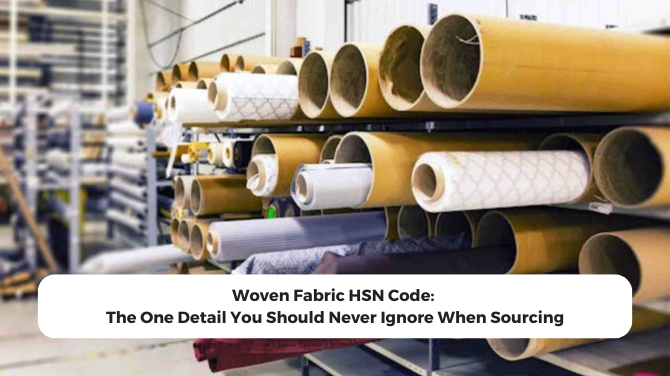Let me tell you about something most buyers don’t talk about until it goes wrong—woven fabric hsn code.
A couple of years ago, one of our newer clients reached out in frustration. They’d just sourced a beautiful yarn dyed woven cotton from another supplier, but their shipment got held up at customs. The paperwork didn’t match the product. Turns out, the HSN code was off. What should’ve been a routine clearance turned into a week-long delay with unexpected fees.
That’s when we realized just how underrated HSN codes are. It’s one of those small details that, if ignored, can slow everything down. But if handled properly, it makes sourcing and shipping a whole lot smoother.
What is an HSN Code?
HSN stands for Harmonized System of Nomenclature. It’s a global classification system developed by the World Customs Organization (WCO) to make international trade more structured.
Each product, whether it’s raw cotton, finished fabric, or a zipper, has its own unique numeric code. These codes help governments identify products for customs, taxation, and regulatory purposes.
For woven fabrics, HSN codes typically start with Chapter 52 (for cotton), Chapter 54 (for synthetics), Chapter 55 (for manmade staple fibers) and so on, depending on what the fabric is made from.
But here’s the tricky part: HSN codes for woven fabrics change based on:
- Fiber content (cotton, polyester, linen, etc.)
- Weave type (plain, dobby, twill)
- Fabric weight (lightweight shirting vs bottom weight)
- Finishing (bleached, dyed, printed, coated)
So using “just any code” won’t cut it.
Why Woven Fabric HSN Code Matters in Real Life
For manufacturers and brands, HSN codes aren’t just for customs declarations. They impact your business in more ways than you might expect:
1. Correct Import Duties
Let’s say you’re importing 1000 meters of a cotton-linen blend. If you mislabel it as 100% cotton under the wrong HSN code, you could end up paying a higher or incorrect duty. And that adds up fast.
2. Faster Customs Clearance
A correct HSN code tells customs officials exactly what’s in the shipment. No need for physical inspection. No long emails back and forth. It moves faster.
3. Invoice and Tax Clarity
If you’re selling fabrics to domestic buyers, GST rates depend on the HSN code. An incorrect one may trigger penalties during audits or lead to confusion in tax returns.
4. Better Inventory and Cataloging
For brands and sourcing teams managing dozens of fabrics, HSN codes help track and classify fabrics internally. It keeps your database organized, especially when working with multiple countries.
Common HSN Codes for Woven Fabrics
Here are some typical HSN codes we work with at Dinesh Exports. These are for reference only. Always verify with your customs advisor based on blend and finish:
| Fabric Type | HSN Code | Description |
| 100% cotton woven (unbleached) | 5208 | Woven fabrics of cotton, not over 200 g/m² |
| 100% cotton dyed or printed | 5209 | Woven cotton fabrics, dyed/printed |
| Poly-cotton blends (less than 85% cotton) | 5513 | Woven fabrics of synthetic and cotton mix |
| Linen blends | 5309 | Woven fabrics of flax |
| Viscose or rayon woven fabrics | 5516 | Woven fabrics of artificial staple fiber |
Again, even within these, the full code is often 8 digits. The last few digits narrow down based on weight, type of dye, or finish.
How We Handle HSN Codes at Dinesh Exports
One thing we do differently here is attach the correct HSN code to every fabric sample and invoice—right from the quoting stage. Whether you’re sourcing a seersucker for spring or a yarn dyed dobby for men’s shirts, you won’t have to chase down paperwork later.
Since we work with global brands across Europe, Japan, the US, and India, we’re used to handling customs in different markets. Our export team cross-verifies every HSN code so buyers can rest easy knowing everything’s compliant.
Plus, all our certified fabrics (GOTS, GRS, OEKO-Tex, BCI, and more) are mapped with appropriate codes for traceability. Read more about hsn codes here
Quick Tips to Avoid HSN Code Mistakes
- Don’t just copy a code from an old invoice. Match it to the current blend and finish.
- Ask your supplier or manufacturer to mention the code on the quote itself.
- Use official government websites or customs tariff books to double-check.
- If unsure, speak to a customs agent. It’s better to clarify before the shipment moves.
Final Word
Woven fabric HSN codes may not be the flashiest part of sourcing, but they’re one of the most important. They help you avoid hidden costs, smoothen shipping, and maintain compliance. And when you’re working across borders or scaling up your production, those small details are what keep things running like clockwork.
If you’re planning your next woven fabric order, we’re happy to help you sort the codes and paperwork right from the start, please contact us here.

